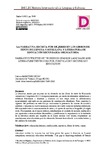La narrativa escrita por mujeres en los libros de texto de Lengua Castellana y Literatura de Educación Secundaria Obligatoria

Ver/Abrir
Use este enlace para citar
http://hdl.handle.net/2183/32604
Excepto si se señala otra cosa, la licencia del ítem se describe como Atribución-CompartirIgual 4.0 Internacional (CC BY-SA 4.0)
Colecciones
Metadatos
Mostrar el registro completo del ítemTítulo
La narrativa escrita por mujeres en los libros de texto de Lengua Castellana y Literatura de Educación Secundaria ObligatoriaTítulo(s) alternativo(s)
Narrative Written by Women in Spanish Language and Literature Textbooks for Compulsory Secondary EducationAutor(es)
Fecha
2022-12-28Cita bibliográfica
Martínez León, P. (2022). La narrativa escrita por mujeres en los libros de texto de Lengua Castellana y Literatura de Educación Secundaria Obligatoria, DIGILEC: Revista Internacional de Lenguas y Culturas, 9, 78-99. https://doi.org/10.17979/digilec.2022.9.0.8953
Resumen
[Resumen] La literatura escrita por mujeres no ha obtenido en los libros de texto de Educación Secundaria Obligatoria (ESO) el espacio merecido, privando de referentes intelectuales y artísticos femeninos a alumnos y alumnas en una etapa como la adolescencia, especialmente relevante en sus procesos de construcción identitaria. Para constatar la vigencia del problema en este trabajo analizamos la presencia de autores de narrativa hombres y mujeres en nueve manuales recientes de cuarto curso de distintas editoriales, diferenciando entre la mera mención de estos y el aporte de una breve biografía y/o algún texto. Previamente, en el marco teórico, introducimos el modelo de escuela coeducativa por oposición a otros modelos disponibles y justificamos la importancia de la inclusión de la literatura escrita por mujeres en el canon escolar. Por último, exponemos las conclusiones más relevantes para la educación literaria derivadas de la revisión teórica y del análisis de manuales. [Abstract] Literature written by women has not been given the space it deserves in Spanish compulsory secondary education textbooks. This gap is depriving students of female intellectual and artistic references at a stage such as adolescence that is especially important in their processes of identity construction. We analyse the presence of male and female narrative authors in nine recent fourth-year textbooks from various publishers, differentiating between the mere mention of these authors and the contribution of a brief biography and/or a text. Previously, in the theoretical framework, we compare the co-educational school model with other models and justify the importance of the inclusion of literature written by women in the school canon. Finally, we present the most relevant conclusions for literary education following a theoretical review and analysis of textbooks.
Palabras clave
Educación literaria
Coeducación
Narrativa
Libros de texto
Canon
Literary education
Coeducation
Narrative
Textbooks
Coeducación
Narrativa
Libros de texto
Canon
Literary education
Coeducation
Narrative
Textbooks
Versión del editor
Derechos
Atribución-CompartirIgual 4.0 Internacional (CC BY-SA 4.0)
ISSN
2386-6691






